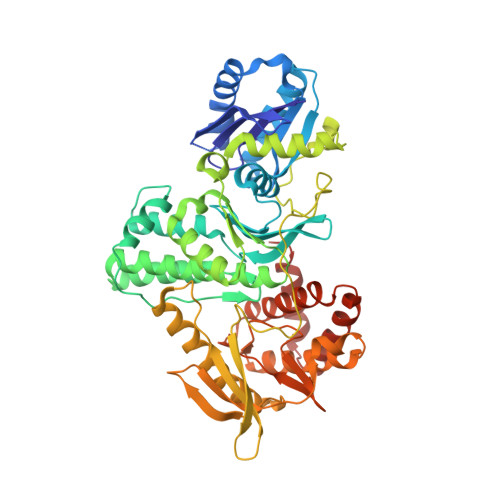Structure of the Archaeal Kae1/Bud32 Fusion Protein Mj1130: A Model for the Eukaryotic Ekc/Keops Subcomplex
Hecker, A., Lopreiato, R., Graille, M., Collinet, B., Forterre, P., Libri, D., Van Tilbeurgh, H.(2008) EMBO J 27: 2340
- PubMed: 19172740
- DOI: https://doi.org/10.1038/emboj.2008.157
- Primary Citation of Related Structures:
2VWB - PubMed Abstract:
The EKC/KEOPS yeast complex is involved in telomere maintenance and transcription. The Bud32p and kinase-associated endopeptidase 1 (Kaelp) components of the complex are totally conserved in eukarya and archaea. Their genes are fused in several archaeal genomes, suggesting that they physically interact. We report here the structure of the Methanocaldococcus jannaschii Kae1/Bud32 fusion protein MJ1130. Kae1 is an iron protein with an ASKHA fold and Bud32 is an atypical small RIO-type kinase. The structure MJ1130 suggests that association with Kae1 maintains the Bud32 kinase in an inactive state. We indeed show that yeast Kae1p represses the kinase activity of yeast Bud32p. Extensive conserved interactions between MjKae1 and MjBud32 suggest that Kae1p and Bud32p directly interact in both yeast and archaea. Mutations that disrupt the Kae1p/Bud32p interaction in the context of the yeast complex have dramatic effects in vivo and in vitro, similar to those observed with deletion mutations of the respective components. Direct interaction between Kae1p and Bud32p in yeast is required both for the transcription and the telomere homeostasis function of EKC/KEOPS.
Organizational Affiliation:
Institut de Génétique et Microbiologie, Université Paris-Sud, IFR115 UMR8621-CNR, Orsay, France.















